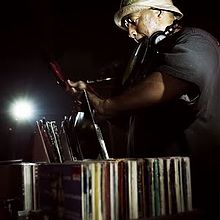
Back أخذ العينات الموسيقية Arabic Sampleig Catalan Samplování Czech Sampling (Musik) German Sampling Spanish نمونهبرداری (موسیقی) Persian Samplaaminen Finnish Sampling Galician דגימה (מוזיקה) HE Uzorkovanje (glazba) Croatian

In sound and music, sampling is the reuse of a portion (or sample) of a sound recording in another recording. Samples may comprise elements such as rhythm, melody, speech, or sound effects. A sample can be brief and only incorporate a single musical note (as is the case with sample-based synthesis), or it can consist of longer portions of music (such as a drumbeat or complete melody), and may be layered, equalized, sped up or slowed down, repitched, looped, or otherwise manipulated. They are usually integrated using electronic music instruments (samplers) or software such as digital audio workstations.
A process similar to sampling originated in the 1940s with musique concrète, experimental music created by splicing and looping tape. The mid-20th century saw the introduction of keyboard instruments that played sounds recorded on tape, such as the Mellotron. The term sampling was coined in the late 1970s by the creators of the Fairlight CMI, a synthesizer with the ability to record and playback short sounds. As technology improved, cheaper standalone samplers with more memory emerged, such as the E-mu Emulator, Akai S950 and Akai MPC.
Sampling is a foundation of hip hop music, which emerged when producers in the 1980s began sampling funk and soul records, particularly drum breaks. It has influenced many other genres of music, particularly electronic music and pop. Samples such as the Amen break, the "Funky Drummer" drum break and the orchestra hit have been used in thousands of recordings, and James Brown, Loleatta Holloway, Fab Five Freddy and Led Zeppelin are among the most sampled artists. The first album created entirely from samples, Endtroducing by DJ Shadow, was released in 1996.
Sampling without permission can infringe copyright or may be fair use. Clearance, the process of acquiring permission to use a sample, can be complex and costly; samples from well-known sources may be prohibitively expensive. Courts have taken different positions on whether sampling without permission is permitted. In Grand Upright Music, Ltd. v. Warner Bros. Records Inc (1991) and Bridgeport Music, Inc. v. Dimension Films (2005), American courts ruled that unlicensed sampling, however minimal, constitutes copyright infringement. However, VMG Salsoul v Ciccone (2016) found that unlicensed samples constituted de minimis copying, and did not infringe copyright. In 2019, the European Court of Justice ruled that modified, unrecognizable samples could be used without authorization. Though some artists sampled by others have complained of plagiarism or lack of creativity, many commentators have argued that sampling is a creative act.